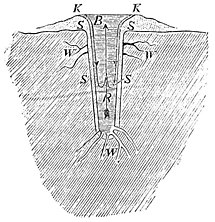and twenty-three and a half metres (seventy-six and a half feet) deep, which widens out above into a tunnel-shaped basin, B, from two to three metres (six and a half to ten feet) deep, and seventeen to twenty metres (fifty-five to sixty and one half feet) in horizontal extent. The  Fig. 1. walls of the basin are formed of a, cone of siliceous sinter, S, from six to nine metres (twenty to thirty feet) high, and about sixty-five metres (more than two hundred feet) broad. The water of the geyser is crystal-clear, with a greenish tint, and flows, except immediately after an eruption, steadily over the rim of the basin. A double motion may be perceived in the column of water inside of the cylinder. A hot stream ascends from the bottom in the axis of the cylinder, while the cooler water descends by the sides, but only to about half-way down, for it there unites with the rising hot current and ascends again to the surface. The temperature of the water is 179° at the surface of the basin; rises at the bottom of the basin to 192, and rises in the bottom of the cylinder to 251° and 260°. The peculiarity of the intermittent streams consists in the fact that their waters mixed with steam are forcibly thrown up in huge jets at longer or shorter intervals. At the Great Geyser, jets of steam, accompanied by detonations raising the water to the height of about ten feet, appear in different parts of the basin at intervals of from one and a half to two hours. At intervals of from twenty-four to thirty hours, a column of water, mixed with steam, rises over the whole extent of the cylinder and the basin, with a sound as of distant thunder, to a height of from twenty-five to thirty metres (eighty to ninety-three feet), and scatters clouds of spray. After an eruption of this kind, the duration of which is about ten minutes, the basin and cylinder are empty; they are gradually filled up again in the course of from four to six hours, after which the processes described above are repeated. The loss of water occasioned by the eruption and overflow is made up for by side-streams, a part of which, W, being near the surface, probably bring in cold water; others, W’, entering at the bottom, water of a higher temperature than the boiling-point.
Fig. 1. walls of the basin are formed of a, cone of siliceous sinter, S, from six to nine metres (twenty to thirty feet) high, and about sixty-five metres (more than two hundred feet) broad. The water of the geyser is crystal-clear, with a greenish tint, and flows, except immediately after an eruption, steadily over the rim of the basin. A double motion may be perceived in the column of water inside of the cylinder. A hot stream ascends from the bottom in the axis of the cylinder, while the cooler water descends by the sides, but only to about half-way down, for it there unites with the rising hot current and ascends again to the surface. The temperature of the water is 179° at the surface of the basin; rises at the bottom of the basin to 192, and rises in the bottom of the cylinder to 251° and 260°. The peculiarity of the intermittent streams consists in the fact that their waters mixed with steam are forcibly thrown up in huge jets at longer or shorter intervals. At the Great Geyser, jets of steam, accompanied by detonations raising the water to the height of about ten feet, appear in different parts of the basin at intervals of from one and a half to two hours. At intervals of from twenty-four to thirty hours, a column of water, mixed with steam, rises over the whole extent of the cylinder and the basin, with a sound as of distant thunder, to a height of from twenty-five to thirty metres (eighty to ninety-three feet), and scatters clouds of spray. After an eruption of this kind, the duration of which is about ten minutes, the basin and cylinder are empty; they are gradually filled up again in the course of from four to six hours, after which the processes described above are repeated. The loss of water occasioned by the eruption and overflow is made up for by side-streams, a part of which, W, being near the surface, probably bring in cold water; others, W’, entering at the bottom, water of a higher temperature than the boiling-point.
The following theories have been advanced in explanation of the periodical eruptions of the Great Geyser, and of the phenomena of intermittent springs generally:
According to Mackenzie's theory, a hollow space, b, Fig. 2, exists in the interior of the earth wherever an intermittent spring occurs,

